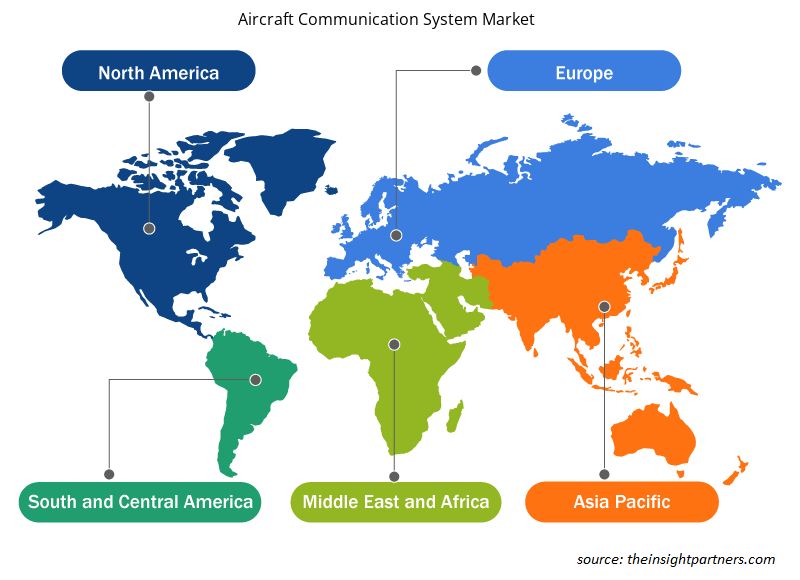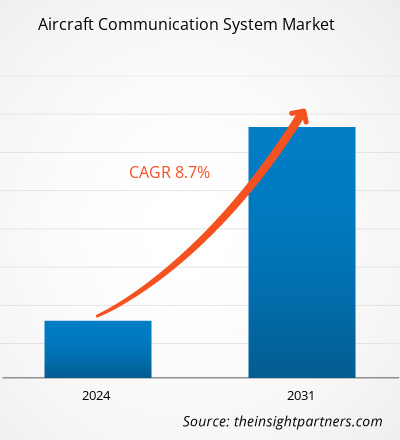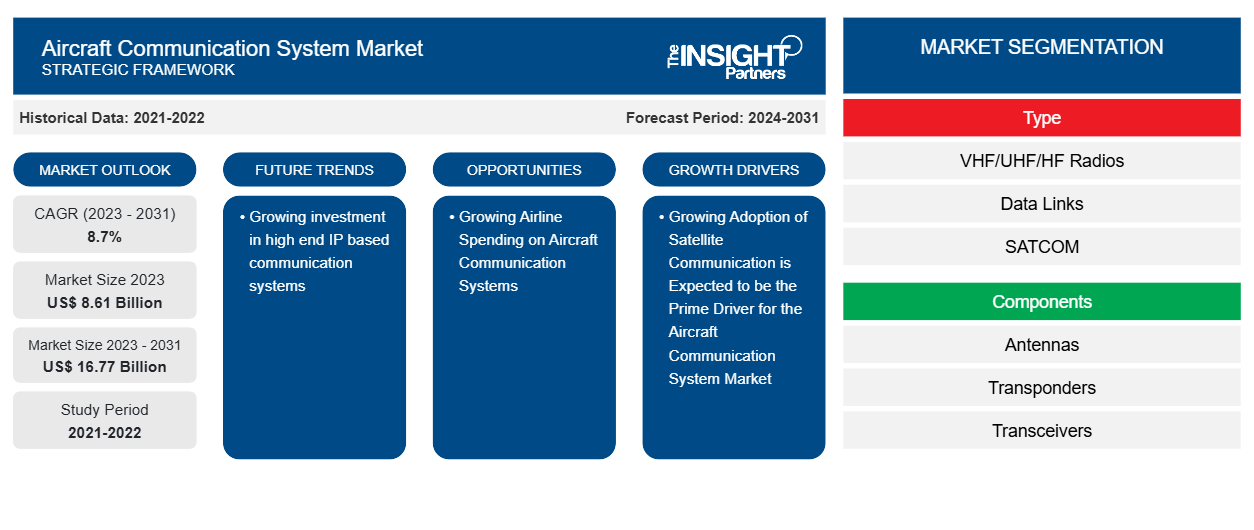Si prevede che la dimensione del mercato dei sistemi di comunicazione per aeromobili raggiungerà i 16,77 miliardi di dollari entro il 2031, rispetto agli 8,61 miliardi di dollari del 2023. Si prevede che il mercato registrerà un CAGR dell'8,7% nel 2023-2031. La crescente domanda di informazioni in tempo reale, scambio di dati e connettività sta agendo come un importante fattore trainante per il mercato dei sistemi di comunicazione per aeromobili a livello globale. La crescente adozione di sistemi di comunicazione di fascia alta come SATCOM migliora l'esperienza dei passeggeri e la gestione del traffico aereo, che sta anche agendo come un importante fattore trainante per il mercato dei sistemi di comunicazione per aeromobili a livello globale.
Analisi di mercato dei sistemi di comunicazione degli aeromobili
I sistemi di comunicazione degli aeromobili sono principalmente sfruttati per lo scambio di dati, la trasmissione vocale, lo scambio di informazioni in tempo reale e la ricezione tra aeromobili o basi di terra. I sistemi di comunicazione degli aeromobili migliorano l'esperienza della sorveglianza della navigazione basata sui satelliti, il che sta influenzando positivamente la crescita del mercato delle comunicazioni degli aeromobili. Per lo più, i fornitori del mercato delle comunicazioni degli aeromobili implementano tecnologie avanzate come la gestione del traffico aereo tramite tecnologie di comunicazione wireless e traiettorie di connettività ad alta velocità. Questi importanti fornitori di sistemi di comunicazione degli aeromobili investono in modo significativo nelle loro attività di ricerca e sviluppo per realizzare sistemi di comunicazione tecnologicamente avanzati per flotte militari e commerciali, che si prevede spingeranno lo sviluppo del mercato dei sistemi di comunicazione degli aeromobili nel periodo di previsione.
Panoramica del mercato dei sistemi di comunicazione degli aeromobili
Il progresso tecnologico dell'elettronica aeronautica, dell'infrastruttura di comunicazione, dei sistemi di controllo di gestione ha un impatto notevole sullo sviluppo del mercato delle comunicazioni aeronautiche. Le comunicazioni aeronautiche hanno ridotto sostanzialmente i casi di incidenti aerei e migliorato la rete di comunicazione in caso di emergenza. Inoltre, si prevede che la tendenza al rialzo dei sistemi di navigazione satellitari per ridurre i tempi di volo e le complessità nella gestione del traffico aereo stimolerà la crescita del mercato dei sistemi di comunicazione aeronautici.
Personalizza questo report in base alle tue esigenze
Riceverai la personalizzazione gratuita di qualsiasi report, comprese parti di questo report, o analisi a livello nazionale, pacchetto dati Excel, oltre a usufruire di grandi offerte e sconti per start-up e università
-
Scopri le principali tendenze di mercato in questo rapporto.Questo campione GRATUITO includerà analisi di dati che spaziano dalle tendenze di mercato alle stime e alle previsioni.
Driver e opportunità del mercato dei sistemi di comunicazione degli aeromobili
Si prevede che la crescente adozione delle comunicazioni satellitari sarà il principale motore del mercato dei sistemi di comunicazione aerea
Il crescente progresso tecnologico nel settore dell'aviazione sta stimolando l'applicazione di infrastrutture di comunicazione basate su satellite. La proliferazione di software-defined radio per stabilire reti di comunicazione satellitare sta agendo come un importante motore per il mercato dei sistemi di comunicazione degli aeromobili. L'infrastruttura di comunicazione satellitare coinvolge un'ampia gamma di tecnologie di rete per servizi di connettività comodi e fluidi tra la flotta e il personale di terra. La flessibilità e la connettività ad alta velocità stanno guidando la domanda di sistemi di comunicazione satellitare che sta agendo come un importante fattore trainante per il mercato dei sistemi di comunicazione degli aeromobili a livello globale.
Crescente spesa delle compagnie aeree per i sistemi di comunicazione degli aeromobili
Le aziende aeronautiche si stanno concentrando sull'integrazione di sistemi di comunicazione di fascia alta per una migliore gestione operativa. I sistemi di comunicazione aeronautici di fascia alta aiutano a stabilire una connessione adeguata tra aeromobile e base di terra in modo conveniente in caso di emergenza. Inoltre, riducono anche il rischio di incidenti aerei. Lo scambio di dati in tempo reale relativi a tempi di volo, posizione, condizioni e controllo sono attributi principali dei sistemi di comunicazione aeronautici. In termini di aeromobili commerciali, la comunicazione tra il pilota e il personale di terra è fondamentale al momento del decollo e dell'atterraggio. Inoltre, gli aeromobili militari o di difesa scambiano anche informazioni cruciali relative alle missioni, come posizione del bersaglio, stato del carburante, posizione della flotta e informazioni critiche guidate dalla missione. Si prevede che la crescente importanza delle reti di comunicazione nel settore dell'aviazione spingerà la crescita del mercato dei sistemi di comunicazione aeronautici nel periodo di previsione.
Analisi della segmentazione del rapporto di mercato del sistema di comunicazione degli aeromobili
I segmenti chiave che hanno contribuito alla derivazione dell'analisi di mercato dei sistemi di comunicazione aeronautici sono tipologia, componenti e tipo di aeromobile.
- In base al tipo, il mercato dei sistemi di comunicazione degli aeromobili è stato suddiviso in radio VHF/UHF/HF, collegamenti dati e SATCOM. Il segmento delle radio VHF/UHF/HF ha detenuto una quota di mercato maggiore nel 2023.SATCOM. The VHF/UHF/HF Radios segment held a larger market share in 2023.
- In termini di componenti, il mercato è stato segmentato in antenne, transponder, transceiver e display e processori. Il segmento dei transponder ha dominato il mercato nel 2023.
- In termini di tipo di aeromobile, il mercato è stato segmentato in aeromobili commerciali e aeromobili militari. I segmenti commerciali hanno dominato il mercato nel 2023.
Analisi della quota di mercato dei sistemi di comunicazione degli aeromobili per area geografica
L'ambito geografico del rapporto sul mercato dei sistemi di comunicazione aeronautici è suddiviso principalmente in cinque regioni: Nord America, Europa, Asia Pacifico, Medio Oriente e Africa e Sud America.
Il Nord America ha guidato il mercato dei sistemi di comunicazione per aeromobili nel 2023. La regione del Nord America comprende Stati Uniti, Canada e Messico. Gli elevati investimenti in tecnologie avanzate e connettività wireless per il settore delle compagnie aeree stanno agendo come un importante motore per il mercato. L'elevata presenza di compagnie aeree e dei principali produttori di sistemi di comunicazione per aeromobili sta anche guidando la crescita del mercato dei sistemi di comunicazione per aeromobili in Nord America. L'aumento delle attività di ricerca e sviluppo nel settore dell'aviazione per migliorare le caratteristiche degli aeromobili commerciali e di difesa per un'infrastruttura di comunicazione più avanzata sta guidando la crescita del mercato dei sistemi commerciali per aeromobili in Nord America.
Approfondimenti regionali sul mercato dei sistemi di comunicazione degli aeromobili
Le tendenze regionali e i fattori che influenzano il mercato dei sistemi di comunicazione aeronautici durante il periodo di previsione sono stati ampiamente spiegati dagli analisti di Insight Partners. Questa sezione discute anche i segmenti e la geografia del mercato dei sistemi di comunicazione aeronautici in Nord America, Europa, Asia Pacifico, Medio Oriente e Africa e America meridionale e centrale.

- Ottieni i dati specifici regionali per il mercato dei sistemi di comunicazione degli aeromobili
Ambito del rapporto di mercato sui sistemi di comunicazione degli aeromobili
| Attributo del report | Dettagli |
|---|---|
| Dimensioni del mercato nel 2023 | 8,61 miliardi di dollari USA |
| Dimensioni del mercato entro il 2031 | 16,77 miliardi di dollari USA |
| CAGR globale (2023-2031) | 8,7% |
| Dati storici | 2021-2022 |
| Periodo di previsione | 2024-2031 |
| Segmenti coperti |
Per tipo
|
| Regioni e Paesi coperti |
America del Nord
|
| Leader di mercato e profili aziendali chiave |
|
Densità degli attori del mercato dei sistemi di comunicazione degli aeromobili: comprendere il suo impatto sulle dinamiche aziendali
Il mercato dei sistemi di comunicazione per aeromobili sta crescendo rapidamente, spinto dalla crescente domanda degli utenti finali dovuta a fattori quali l'evoluzione delle preferenze dei consumatori, i progressi tecnologici e una maggiore consapevolezza dei vantaggi del prodotto. Con l'aumento della domanda, le aziende stanno ampliando le loro offerte, innovando per soddisfare le esigenze dei consumatori e capitalizzando sulle tendenze emergenti, il che alimenta ulteriormente la crescita del mercato.
La densità degli operatori di mercato si riferisce alla distribuzione di aziende o società che operano in un particolare mercato o settore. Indica quanti concorrenti (operatori di mercato) sono presenti in un dato spazio di mercato in relazione alle sue dimensioni o al valore di mercato totale.
Le principali aziende che operano nel mercato dei sistemi di comunicazione aerea sono:
- Honeywell International Inc
- Società Northrop Grumman
- Società dinamica generale
- Tecnologie L3Harris Inc.
- Società Cobham
- Gruppo Talete
Disclaimer : le aziende elencate sopra non sono classificate secondo un ordine particolare.

- Ottieni la panoramica dei principali attori del mercato dei sistemi di comunicazione aeronautica
Notizie di mercato e sviluppi recenti sui sistemi di comunicazione degli aeromobili
Il mercato dei sistemi di comunicazione per aeromobili viene valutato raccogliendo dati qualitativi e quantitativi dopo la ricerca primaria e secondaria, che include importanti pubblicazioni aziendali, dati associativi e database. Di seguito è riportato un elenco degli sviluppi nel mercato dei sistemi di comunicazione per aeromobili e delle strategie:
- Nell'agosto 2023, la Northrop Grumman Corporation, in collaborazione con l'aeronautica militare statunitense, ha completato una dimostrazione di trasferimento di missione aviotrasportata integrata (IAMT) con il B-2 Spirit presso la base aerea di Whiteman. (Fonte: Northrop Grumman Corporation, comunicato stampa/sito Web aziendale/newsletter)
- Ad aprile 2024, Thales Group ha acquisito Cobham Aerospace Communications per rafforzare la propria presenza nelle comunicazioni di sicurezza in cabina di pilotaggio. (Fonte: Thales Group, comunicato stampa/sito Web aziendale/newsletter)
Copertura e risultati del rapporto sul mercato dei sistemi di comunicazione degli aeromobili
Il rapporto "Dimensioni e previsioni del mercato dei sistemi di comunicazione aeronautica (2021-2031)" fornisce un'analisi dettagliata del mercato che copre le seguenti aree:
- Dimensioni e previsioni del mercato a livello globale, regionale e nazionale per tutti i segmenti di mercato chiave coperti dall'ambito
- Dinamiche di mercato come fattori trainanti, vincoli e opportunità chiave
- Principali tendenze future
- Analisi PEST dettagliata
- Analisi di mercato globale e regionale che copre le principali tendenze di mercato, i principali attori, le normative e gli sviluppi recenti del mercato
- Analisi del panorama industriale e della concorrenza che copre la concentrazione del mercato, l'analisi della mappa di calore, i principali attori e gli sviluppi recenti
- Profili aziendali dettagliati con analisi SWOT
- Analisi storica (2 anni), anno base, previsione (7 anni) con CAGR
- Analisi PEST e SWOT
- Valore/volume delle dimensioni del mercato - Globale, Regionale, Nazionale
- Industria e panorama competitivo
- Set di dati Excel
Report recenti
Testimonianze
Motivo dell'acquisto
- Processo decisionale informato
- Comprensione delle dinamiche di mercato
- Analisi competitiva
- Analisi dei clienti
- Previsioni di mercato
- Mitigazione del rischio
- Pianificazione strategica
- Giustificazione degli investimenti
- Identificazione dei mercati emergenti
- Miglioramento delle strategie di marketing
- Aumento dell'efficienza operativa
- Allineamento alle tendenze normative























 Ottieni un campione gratuito per - Mercato dei sistemi di comunicazione aeronautici
Ottieni un campione gratuito per - Mercato dei sistemi di comunicazione aeronautici